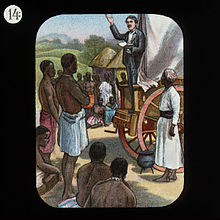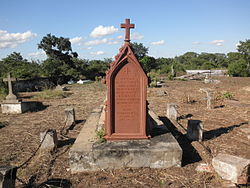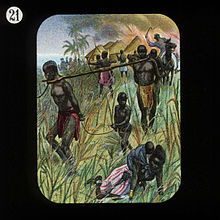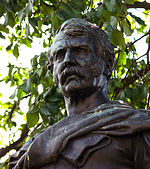
David Livingstone
Background Information
SOS Children made this Wikipedia selection alongside other schools resources. All children available for child sponsorship from SOS Children are looked after in a family home by the charity. Read more...
| David Livingstone | |
|---|---|
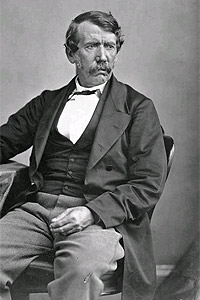 |
|
| Born | 19 March 1813 Blantyre, South Lanarkshire, Scotland, UK |
| Died | 1 May 1873 (aged 60) Chief Chitambo's Village, North-Eastern Rhodesia |
| Cause of death | Malaria and internal bleeding due to dysentery |
| Resting place | The Collegiate Church of St Peter at Westminster, London 51.499444°N 0.1275°W |
| Nationality | Scottish / British |
| Known for | Exploration of Africa |
| Religion | Congregationalist |
| Spouse(s) | Mary Livingstone (née Moffat) |
David Livingstone (19 March 1813 – 1 May 1873) was a Scottish Congregationalist pioneer medical missionary with the London Missionary Society and an explorer in Africa. His meeting with H. M. Stanley in October 1871 gave rise to the popular quotation "Dr. Livingstone, I presume?"
Perhaps one of the most popular national heroes of the late 19th century in Victorian Britain, Livingstone had a mythic status, which operated on a number of interconnected levels: that of Protestant missionary martyr, that of working-class "rags to riches" inspirational story, that of scientific investigator and explorer, that of imperial reformer, anti-slavery crusader, and advocate of commercial empire.
His fame as an explorer helped drive forward the obsession with discovering the sources of the River Nile that formed the culmination of the classic period of European geographical discovery and colonial penetration of the African continent. At the same time his missionary travels, "disappearance" and death in Africa, and subsequent glorification as posthumous national hero in 1874 led to the founding of several major central African Christian missionary initiatives carried forward in the era of the European "Scramble for Africa".
Early life
David Livingstone was born on 19 March 1813 in the mill town of Blantyre, in a tenement building for the workers of a cotton factory on the banks of the Clyde River under the bridge crossing into Bothwell, Lanarkshire, Scotland. He was the second of seven children born to Neil Livingstone (1788–1856) and his wife Agnes Hunter (1782–1865). Along with many of the Livingstones, David was at the age of ten employed in the cotton mill of H. Monteith & Co. in the village of Blantyre Works. David and his brother John worked twelve-hour days as piecers, tying broken cotton threads on the spinning machines. He was a student at the Charing Cross Hospital Medical School from 1838 to 1840 where his courses covered medical practice, midwifery and botany.
Livingstone's father Neil was very committed to his beliefs, a Sunday School teacher and teetotaller who handed out Christian tracts on his travels as a door to door tea salesman, and who read extensively books on theology, travel and missionary enterprises. This rubbed off on the young David, who became an avid reader, but he also loved scouring the countryside for animal, plant and geological specimens in local limestone quarries. Neil Livingstone had a fear of science books as undermining Christianity and attempted to force him to read nothing but theology, but David's deep interest in nature and science led him to investigate the relationship between religion and science. When in 1832 he read Philosophy of a Future State by the science teacher, amateur astronomer and church minister Thomas Dick, he found the rationale he needed to reconcile faith and science, and apart from the Bible this book was perhaps his greatest philosophical influence.
Other significant influences in his early life were Thomas Burke, a Blantyre evangelist and David Hogg, his Sabbath School teacher. At age nineteen, David and his father left the Church of Scotland for a local Congregational church, influenced by preachers like Ralph Wardlaw who denied predestinatarian limitations on salvation. Influenced by American revivalistic teachings, Livingstone's reading of the missionary Karl Gützlaff's "Appeal to the Churches of Britain and America on behalf of China" enabled him to persuade his father that medical study could advance religious ends.
Livingstone's experience from age 10 to 26 in H. Monteith's Blantyre cotton mill, first as a piecer and later as a spinner, was also important. Necessary to support his impoverished family, this work was monotonous but taught him persistence, endurance, and a natural empathy with all who labour, as expressed by lines he used to hum from the egalitarian Rabbie Burns song: "When man to man, the world o'er / Shall brothers be for a' that".
Livingstone attended Blantyre village school along with the few other mill children with the endurance to do so despite their 14-hour workday (6 am–8 pm), but having a family with a strong, ongoing commitment to study also reinforced his education. After reading Gutzlaff's appeal for medical missionaries for China in 1834, he began saving money and in 1836 entered Anderson's College (now University of Strathclyde) in Glasgow, founded to bring science and technology to ordinary folk, and attended Greek and theology lectures at the University of Glasgow. It is now known that to enter Medical School he required some knowledge of Latin. A local Roman Catholic, Daniel Gallagher, helped him learn Latin to the required level. Later in life Gallagher became a Catholic priest and founded the third oldest Catholic Church in Glasgow, St. Simon's Church, Partick. The Church was originally named St. Peter's. A painting of both Gallagher and Livingstone by Roy Petrie hangs in that church's coffee room. In addition, he attended divinity lectures by Wardlaw, a leader at this time of vigorous anti-slavery campaigning in the city. Shortly after, he applied to join the London Missionary Society (LMS) and was accepted subject to missionary training. He continued his medical studies in London while training there and was attached to a church in Ongar, Essex, to be a minister under LMS. Despite his impressive personality, he was a plain preacher and would have been rejected by the LMS had not the director given him a second chance to pass the course.
Livingstone hoped to go to China as a missionary, but the First Opium War broke out in September 1839 and the LMS suggested the West Indies instead. In 1840, while continuing his medical studies in London, Livingstone met LMS missionary Robert Moffat, on leave from Kuruman, a missionary outpost in South Africa, north of the Orange River. Excited by Moffat's vision of expanding missionary work northwards, and influenced by abolitionist T.F. Buxton's arguments that the African slave trade might be destroyed through the influence of "legitimate trade" and the spread of Christianity, Livingstone focused his ambitions on Southern Africa. He was deeply influenced by Moffat's judgment that he was the right person to go to the vast plains to the north of Bechuanaland, where he had glimpsed "the smoke of a thousand villages, where no missionary had ever been."
David Livingstone also lived in Hamilton, South Lanarkshire from 1862 for a short time. The house still stands and has a plaque can be seen outside the house (17 Burnbank Road). He was also awarded the freedom of the town of Hamilton.
Exploration of southern and central Africa
After the Kolobeng mission had to be closed because of drought, he explored the African interior to the north, in the period 1852–56, and was the first European to see the Mosi-oa-Tunya ("the smoke that thunders") waterfall (which he renamed Victoria Falls after his monarch, Queen Victoria), of which he wrote later, "Scenes so lovely must have been gazed upon by angels in their flight." (Jeal, p. 149)
Livingstone was one of the first Westerners to make a transcontinental journey across Africa, Luanda on the Atlantic to Quelimane on the Indian Ocean near the mouth of the Zambezi, in 1854–56. Despite repeated European attempts, especially by the Portuguese, central and southern Africa had not been crossed by Europeans at that latitude owing to their susceptibility to malaria, dysentery and sleeping sickness which was prevalent in the interior and which also prevented use of draught animals (oxen and horses), as well as to the opposition of powerful chiefs and tribes, such as the Lozi, and the Lunda of Mwata Kazembe.
The qualities and approaches which gave Livingstone an advantage as an explorer were that he usually travelled lightly, and he had an ability to reassure chiefs that he was not a threat. Other expeditions had dozens of soldiers armed with rifles and scores of hired porters carrying supplies, and were seen as military incursions or were mistaken for slave-raiding parties. Livingstone on the other hand travelled on most of his journeys with a few servants and porters, bartering for supplies along the way, with a couple of guns for protection. He preached a Christian message but did not force it on unwilling ears; he understood the ways of local chiefs and successfully negotiated passage through their territory, and was often hospitably received and aided, even by Mwata Kazembe.
Livingstone was a proponent of trade and Christian missions to be established in central Africa. His motto, inscribed in the base of the statue to him at Victoria Falls, was "Christianity, Commerce and Civilization." At this time he believed the key to achieving these goals was the navigation of the Zambezi River as a Christian commercial highway into the interior. He returned to Britain to try to garner support for his ideas, and to publish a book on his travels which brought him fame as one of the leading explorers of the age.
Believing he had a spiritual calling for exploration rather than mission work, and encouraged by the response in Britain to his discoveries and support for future expeditions, in 1857 he resigned from the London Missionary Society after they demanded that he do more evangelizing and less exploring. With the help of the Royal Geographical Society's president, Livingstone was appointed as Her Majesty's Consul for the East Coast of Africa.
Zambezi expedition
The British government agreed to fund Livingstone's idea and he returned to Africa as head of the Zambezi Expedition to examine the natural resources of southeastern Africa and open up the River Zambezi. Unfortunately it turned out to be completely impassable to boats past the Cahora Bassa rapids, a series of cataracts and rapids that Livingstone had failed to explore on his earlier travels.
The expedition lasted from March 1858 until the middle of 1864. Expedition members recorded that Livingstone was an inept leader incapable of managing a large-scale project. He was also said to be secretive, self-righteous, moody and could not tolerate criticism which severely strained the expedition and which led to his physician, John Kirk, writing in 1862, "I can come to no other conclusion than that Dr. Livingstone is out of his mind and a most unsafe leader". The artist Thomas Baines was dismissed from the expedition on charges (which he vigorously denied) of theft. The expedition became the first to reach Lake Malawi and they explored it in a four-oared gig. In 1862 they returned to the coast to await the arrival of a steam boat specially designed to sail on Lake Malawi. Mary Livingstone also arrived along with the boat. She died on 27 April 1862 of malaria and Livingstone continued his explorations. Attempts to navigate the Ruvuma River failed because of the continual fouling of the paddle wheels from the bodies thrown in the river by slave traders, and Livingstone's assistants gradually died or left him. It was at this point that he uttered his most famous quote, "I am prepared to go anywhere, provided it be forward." He eventually returned home in 1864 after the government ordered the recall of the expedition because of its increasing costs and failure to find a navigable route to the interior. The Zambezi Expedition was castigated as a failure in many newspapers of the time, and Livingstone experienced great difficulty in raising funds to further explore Africa. Nevertheless John Kirk, Charles Meller, and Richard Thornton, the scientists appointed to work under Livingstone, did contribute large collections of botanic, ecological, geological and ethnographic material to scientific Institutions in the United Kingdom.
The River Nile
In January 1866, Livingstone returned to Africa, this time to Zanzibar, from where he set out to seek the source of the Nile. Richard Francis Burton, John Hanning Speke and Samuel Baker had (although there was still serious debate on the matter) identified either Lake Albert or Lake Victoria as the source (which was partially correct, as the Nile "bubbles from the ground high in the mountains of Burundi halfway between Lake Tanganyika and Lake Victoria"). Livingstone believed the source was further south and assembled a team of freed slaves, Comoros Islanders, twelve Sepoys and two servants, Chuma and Susi, from his previous expedition to find it.
Setting out from the mouth of the Ruvuma river Livingstone's assistants began deserting him. The Comoros Islanders had returned to Zanzibar and informed authorities that Livingstone had died. He reached Lake Malawi on 6 August, by which time most of his supplies, including all his medicines, had been stolen. Livingstone then travelled through swamps in the direction of Lake Tanganyika. With his health declining he sent a message to Zanzibar requesting supplies be sent to Ujiji and he then headed west. Forced by ill health to travel with slave traders he arrived at Lake Mweru on 8 November 1867 and continued on, travelling south to become the first European to see Lake Bangweulu. Finding the Lualaba River, Livingstone mistakenly concluded it was the high part of the Nile River; in fact it flows into the River Congo at Upper Congo Lake.
The year 1869 began with Livingstone finding himself extremely ill whilst in the jungle. He was saved by Arab traders who gave him medicines and carried him to an Arab outpost. In March 1869 Livingstone, suffering from pneumonia, arrived in Ujiji to find his supplies stolen. Coming down with cholera and tropical ulcers on his feet he was again forced to rely on slave traders to get him as far as Bambara where he was caught by the wet season. With no supplies, Livingstone had to eat his meals in a roped off open enclosure for the entertainment of the locals in return for food.
On 15 July 1871, according to Livingstone's recently released original handwritten diaries, while he was visiting the town of Nyangwe on the banks of the Lualaba River, he witnessed around 400 Africans being massacred by slavers. The massacre horrified Livingstone, leaving him too shattered to continue his mission to find the source of the Nile. Following the end of the wet season, he travelled 240 miles from Nyangwe – violently ill most of the way – back to Ujiji, an Arab settlement on the eastern shore of Lake Tanganyika, arriving on 23 October 1871.
Geographical discoveries
Although Livingstone was wrong about the Nile, he discovered for Western science numerous geographical features, such as Lake Ngami, Lake Malawi, and Lake Bangweulu in addition to Victoria Falls mentioned above. He filled in details of Lake Tanganyika, Lake Mweru and the course of many rivers, especially the upper Zambezi, and his observations enabled large regions to be mapped which previously had been blank. Even so, the furthest north he reached, the north end of Lake Tanganyika, was still south of the Equator and he did not penetrate the rainforest of the River Congo any further downstream than Ntangwe near Misisi.
Livingstone was awarded the gold medal of the Royal Geographical Society of London and was made a Fellow of the society, with which he had a strong association for the rest of his life.
Stanley meeting
Livingstone completely lost contact with the outside world for six years and was ill for most of the last four years of his life. Only one of his 44 letter dispatches made it to Zanzibar. One surviving letter to Horace Waller, made available to the public in 2010 by its owner Peter Beard, reads: "I am terribly knocked up but this is for your own eye only, ... Doubtful if I live to see you again ..."
Henry Morton Stanley, who had been sent to find him by the New York Herald newspaper in 1869, found Livingstone in the town of Ujiji on the shores of Lake Tanganyika on 10 November 1871, greeting him with the now famous words "Dr. Livingstone, I presume?" to which he responded "Yes", and then "I feel thankful that I am here to welcome you." These famous words may have been a fabrication, as Stanley later tore out the pages of this encounter in his diary. Even Livingstone's account of this encounter does not mention these words. However, the phrase appears in a New York Herald editorial dated 10 August 1872, and the Encyclopædia Britannica and the Oxford Dictionary of National Biography both quote it without questioning its veracity. The words are famous because of their perceived tongue-in-cheek humorous nature: Dr. Livingstone was the only white person for hundreds of miles. Stanley's book suggests that it was really because of embarrassment, because he did not dare to embrace him.
Despite Stanley's urgings, Livingstone was determined not to leave Africa until his mission was complete. His illness made him confused and he had judgment difficulties at the end of his life. He explored the Lualaba and, failing to find connections to the Nile, returned to Lake Bangweulu and its swamps to explore possible rivers flowing out northwards.
Christianity
Although Livingstone is known both as a great explorer and Christian missionary, he is only recorded as having converted one African: Sechele who was the chief of the Bakwena tribe.
Death
David Livingstone died in that area in Chief Chitambo's village at Ilala southeast of Lake Bangweulu in present-day Zambia on 1 May 1873 from malaria and internal bleeding caused by dysentery. He took his final breaths while kneeling in prayer at his bedside. (His journal indicates that the date of his death would have been 1 May, but his attendants noted the date as 4 May, which they carved on a tree and later reported; this is the date on his grave.) His two followers, Susi and Chuma on the morning of his death made the decision to remove the heart and prepare the body for carrying to the coast for subsequent shipping to England. Livingstone's heart was buried under a Mvula tree near the spot where he died, now the site of the Livingstone Memorial. His body together with his journal was carried over a thousand miles by his loyal attendants Chuma and Susi to the coast to Bagamoyo, and was returned to Britain for burial. After lying in repose at No.1 Savile Row—then the headquarters of the Royal Geographical Society, now the home of bespoke tailors Gieves & Hawkes— his remains were interred at Westminster Abbey, London.
Livingstone and slavery
"And if my disclosures regarding the terrible Ujijian slavery should lead to the suppression of the East Coast slave trade, I shall regard that as a greater matter by far than the discovery of all the Nile sources together." – Livingstone in a letter to the editor of the New York Herald.
"We passed a slave woman shot or stabbed through the body and lying on the path. [Onlookers] said an Arab who passed early that morning had done it in anger at losing the price he had given for her, because she was unable to walk any longer".
Livingstone's letters, books, and journals did stir up public support for the abolition of slavery; however, he became humiliatingly dependent for assistance on the very slave-traders whom he wanted to put out of business. Because he was a poor leader of his peers, he ended up on his last expedition as an individualist explorer with servants and porters but no expert support around him. At the same time he did not use the brutal methods of maverick explorers such as Stanley to keep his retinue of porters in line and his supplies secure. For these reasons from 1867 onwards he accepted help and hospitality from Mohamad Bogharib and Mohamad bin Saleh (also known as Mpamari), traders who kept and traded in slaves, as he recounts in his journals. They in turn benefited from Livingstone's influence with local people, which facilitated Mpamari's release from bondage to Mwata Kazembe.
Livingstone was also furious to discover some of the replacement porters sent at his request from Ujiji were slaves.
Legacy
By the late 1860s Livingstone's reputation in Europe had suffered owing to the failure of the missions he set up, and of the Zambezi Expedition; and his ideas about the source of the Nile were not supported. His expeditions were hardly models of order and organization.
His reputation was rehabilitated by Stanley and his newspaper, and by the loyalty of Livingstone's servants whose long journey with his body inspired wonder. The publication of his last journal revealed stubborn determination in the face of suffering.
He had made geographical discoveries for European knowledge. He inspired abolitionists of the slave trade, explorers and missionaries. He opened up Central Africa to missionaries who initiated the education and health care for Africans, and trade by the African Lakes Company. He was held in some esteem by many African chiefs and local people and his name facilitated relations between them and the British.
Partly as a result, within fifty years of his death, colonial rule was established in Africa and white settlement was encouraged to extend further into the interior.
Within a further fifty years after that, two other aspects of his legacy paradoxically helped end the colonial era in Africa without excessive bloodshed. Livingstone was part of an evangelical and nonconformist movement in Britain which during the 19th century changed the national mindset from the notion of a divine right to rule 'lesser races', to ethical ideas in foreign policy which, with other factors, contributed to the end of the British Empire. Secondly, Africans educated in mission schools founded by people inspired by Livingstone were at the forefront of national independence movements in central, eastern and southern Africa.
The David Livingstone Centre in Blantyre celebrates his life and is based in the house in which he was born, on the site of the mill in which he started his working life. His Christian faith is evident in his journal, where one entry reads: "I place no value on anything I have or may possess, except in relation to the kingdom of Christ. If anything will advance the interests of the kingdom, it shall be given away or kept, only as by giving or keeping it I shall promote the glory of Him to whom I owe all my hopes in time and eternity."
Family life
While Livingstone had a great impact on British Imperialism, he did so at a tremendous cost to his family. In his absences, his children grew up missing their father, and his wife Mary (daughter of Mary and Robert Moffat) endured very poor health, and died of malaria trying to follow him in Africa. He had six children: Robert reportedly died in the American Civil War; Agnes (b.1847), Thomas, Elizabeth (who died two months after her birth), William Oswell (nicknamed Zouga because of the river along which he was born, in 1851) and Anna Mary (b.1858). Only Agnes, William Oswell and Anna Mary married and had children.
His one regret in later life was that he did not spend enough time with his children, whom he loved immensely.
Archives
The archives of David Livingstone are maintained by the Archives of the University of Glasgow (GUAS). On November 11, 2011, Livingstone's 1871 Field Diary, as well as other original works, was published online for the first time by the David Livingstone Spectral Imaging Project, an eighteen-month, transatlantic collaboration between scholars, scientists and educational and archival institutions."
Papers relating to Livingstone's time as a London Missionary Society missionary (including hand-annotated maps of South East Africa) are held by the Archives of the School of Oriental and African Studies.
Places named in his honour and other memorials
In Africa
- Livingstone Hall, Men's Hall of residence at Makerere University, Kampala, Uganda.
- The Livingstone Memorial in Ilala, Zambia marks where he died.
- The city of Livingstone, Zambia which includes a memorial in front of the Livingstone Museum and a new statue erected in 2005.
- The Rhodes–Livingstone Institute in Livingstone and Lusaka, Zambia, 1940s to 1970s, was a pioneering research institution in urban anthropology.
- David Livingstone Teachers' Training College, Livingstone, Zambia.
- The David Livingstone Memorial statue at Victoria Falls, Zimbabwe, erected in 1954 on the western bank of the falls.
- A new statue of David Livingstone was erected in November 2005 on the Zambian side of Victoria Falls.
- A plaque was unveiled in November 2005 at Livingstone Island on the lip of Victoria Falls marking where Livingstone stood to get his first view of the falls.
- The town of Livingstonia, Malawi.
- The city of Blantyre, Malawi is named after his birthplace in Lanarkshire, Scotland, and includes a memorial.
- The David Livingstone Scholarships for students at the University of Malawi, funded through Strathclyde University, Scotland.
- The David Livingstone Clinic was founded by the University of Strathclyde's Millennium Project in Lilongwe, Malawi.
- The Kipengere Range in south-west Tanzania at the north-eastern end of Lake Malawi is also called the Livingstone Mountains.
- Livingstone Falls on the River Congo, named by Stanley.
- The Livingstone Inland Mission, a Baptist mission to the Congo Free State 1877–1884, located in what is now Kinshasa.
- A memorial in Ujiji commemorates his meeting with Stanley.
- The Livingstone–Stanley Monument, Mugere, Burundi marks a spot that Livingstone and Stanley visited on their exploration of Lake Tanganyika, mistaken by some as the first meeting place of the two explorers.
- Scottish Livingstone Hospital in Molepolole 50 km west of Gaborone, Botswana
- There is a memorial to Livingstone at the ruins of the Kolobeng Mission, 40 km west of Gaborone, Botswana.
- The church tower of the Catholic Holy Ghost Mission in Bagamoyo, Tanzania, is called Livingstone Tower because his body was laid down there for one night before it was shipped to London.
- Livingstone House in Stone Town, Zanzibar, provided by the Sultan for Livingstone's use, January to March 1866, to prepare his last expedition; the house was purchased by the Zanzibar government in 1947.
- Plaque commemorating his departure from Mikindani on his final expedition on the wall of the house that has been built over the house he reputedly stayed in.
- David Livingstone Primary School in Harare, Zimbabwe.
- David Livingstone Secondary School in Ntabazinduna about 40 km from Bulawayo, Zimbabwe.
- David Livingstone Senior Secondary School in Schauderville, Port Elizabeth, South Africa.
- Livingstone House in Harare, Zimbabwe, designed by Leonora Granger.
In New Zealand
- Livingstone Street in Westmere, Auckland
In Scotland
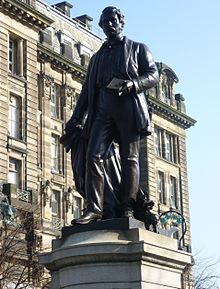
- A statue stands near the base of the Scott Monument in the Princes Street Gardens, Edinburgh, Scotland.
- The David Livingstone Centre in Blantyre, Scotland, is a museum in his honour.
- David Livingstone Memorial Primary School in his birthplace, Blantyre, Lanarkshire, Scotland.
- David Livingstone Memorial Church of the Church of Scotland, in Blantyre, Lanarkshire, Scotland.
- A statue of Livingstone is sited in Cathedral Square, Glasgow.
- A bust of David Livingstone is among those of famous Scotsmen in the William Wallace Memorial near Stirling, Scotland.
- Strathclyde University, Glasgow (successor to Anderson's University), commemorates him in the David Livingstone Centre for Sustainability and the Livingstone Tower where there is a statue of him.
- The David Livingstone (Anderson College) Memorial Prize in Physiology commemorates him at the University of Glasgow.
- Livingstone Place, a street in the Marchmont neighbourhood of Edinburgh.
- Livingstone Street in Addiewell.
- A memorial plaque commemorating the centenary of Livingstone's birth was dedicated in St. James's Congregational Church, the church he attended as a boy.
In Canada
- The Livingstone Range of mountains in southern Alberta.
- David Livingstone Elementary School, Vancouver
- David Livingstone Community School, Winnipeg
- Bronze bust in Halifax, Nova Scotia.
In the USA
- Livingstone College, Salisbury, North Carolina.
- Livingstone Adventist Academy, Salem, Oregon.
In South America
- The Livingstone Healthservice in Jardìn Amèrica, Misiones, Argentina is named in his honour.
Biology
- The Lake Malawi Cichlid Nimbochromis livingstonii is named in honour of David Livingstone.
Portrayal in film
Livingstone has been portrayed by M.A. Wetherell in Livingstone (1925), Percy Marmont in David Livingstone (1936), Cedric Hardwicke in Stanley and Livingstone (1939), and Bernard Hill in Mountains of the Moon (1990).


